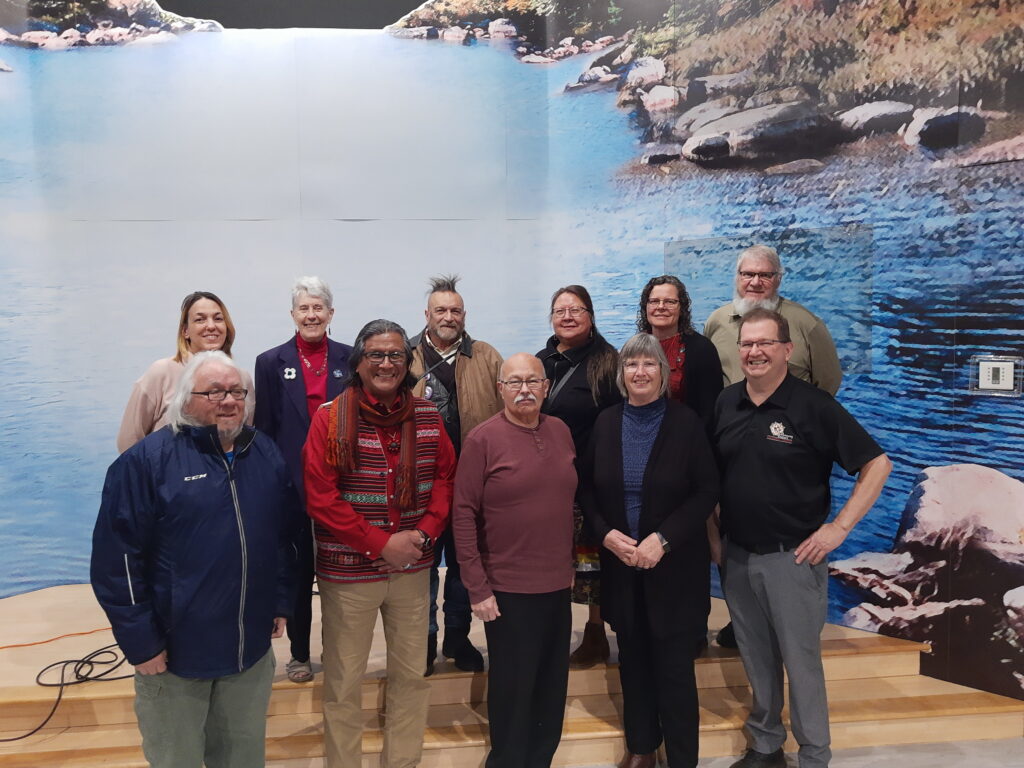Enriching gathering in Mi’kma’ki feeds the work of KAIROS Indigenous Rights Circle and Partners

In April, KAIROS Indigenous Rights Circle (KIRC) held enriching meetings and site visits at Millbrook First Nation in Mi’kma’ki.
The three-day gathering was held at the Millbrook Cultural and Heritage Centre which houses several displays of Mi’kmaw history and culture. It was a wonderful venue with space for quiet reflection and inspiration. With careful planning by host member, Dick Cotterill and another member, Jose Zarate, Circle members engaged in interactive sessions with three groups of Indigenous people.
KIRC has been part of KAIROS since its beginning. This group of Indigenous and non-Indigenous people meet to help KAIROS as a whole to further Indigenous rights.
Heather Stevens and Jeff Wilmot, staff at the Centre, welcomed the KIRC members with a prayer and smudge. They explained the history of the Centre and its displays. Heather gave an emotional account of her role in the repatriation of Mi’kmaw regalia from the Melbourne Museum in Australia. The artifacts had been donated to that museum more than a century ago.
Shannon Neufeldt, Member Relations and Network Coordinator for KAIROS, joined the members of KIRC for the three days. Accompanying her on the first day, Leah Ressor-Keller, Interim Executive Director of KAIROS, presented critical information regarding the current status of KAIROS and guided a review of KIRC’S past work. Since its origins as the KAIROS Aboriginal Rights Committee, the Circle has grown and developed. This in-person meeting helped KIRC to refine a vision for its future work.
On the second day, Circle members welcomed Don Julien and Tim Bernard from the Confederacy of Mainland Mi’kmaq who shared Mi’kmaw history and plans for the Mi’kmawey Debert Cultural Centre, which is to be constructed on the site of ancient Mi’kmaw habitation near the Bay of Fundy. Archeologists have been working at the site for several years and thousands of artifacts have been recovered. These artifacts date back as far as 13,500 years ago and provide evidence of the continual presence of the Mi’kmaq.

On the third day, Circle members travelled to Sipekne’katik First Nation. This is the reclaimed traditional Indigenous name for the community, also commonly known as Indian Brook or Shubenacadie First Nation. Sipekne’katik means “where the wild potatoes grow.” The Circle met several people including four members of the Mi’kmaw Grand Council. The Grand Council is the historic governing body of the Mi’kmaw Nation, which includes communities from all of Mi’kma’ki.
Mi’kma’ki covers a huge geographic area from present-day Newfoundland to the Gaspe peninsula of Quebec, including all of Nova Scotia, all of Prince Edward Island much of New Brunswick and bit of the state of Maine.
The Grand Council members shared stories of their efforts to protect their lands and communities from environmental destruction. They have taken matters into their own hands and hired scientists and researchers, collecting ample data to support their claims that industry and colonial ways are causing suffering and grave danger to the land, the waters and their inhabitants. In the end they asked, “Why are you asking?” and “What are you going to do with our stories?” It was a reminder for the Circle to evaluate its ways of engagement. How is it coming into relationship with Indigenous peoples across Turtle Island? Is it coming in ways that open the door to right relationships?
Before returning to Millbrook to complete our meeting, the Circle visited the site of the former Shubenacadie Indian Residential School on the banks of the Shubenacadie River. Another KIRC member, Yvonne Bearbull, had brought some tobacco. Circle members each took a pinch or a small handful and, after a collective moment, went their own way to reflect and pray and leave the tobacco by a tree, a toy, a monument or in the water. So much care and love has been poured out at the site, as evidenced by the many stuffed animals, shoes, lovely food and tobacco ties that have been left in memory of the students. The offerings represent the things the students didn’t have when they were at school. This was another very emotional time and had a special meaning for all the Circle members. The richness of these visits “in community” feed the work of the KAIROS Indigenous Rights Circle, surfacing stories of struggle and resilience, in small steps forging relationships and good will with Indigenous peoples across Turtle Island.
